Saguna Brahman, The Great God
To
ordinary mortals the Nirguna Brahman (without form or attributes) is impersonal
and hard to comprehend. Therefore, in relation to the world and to make the
Universal Spirit easily understandable, we have the Saguna Brahman, or the
Brahman with form and attributes who is known as the One Great God or Ishwara.
To those less developed spiritually and to the average man and woman, the
concept of God has to be one with a form, a sort of Superior Being in human
form on whom one can fix one's mind, especially during prayer.
The Trinity
The
three main functions of God-head, Creation, Preservation and Destruction, are
further simplified by the One Great God, Ishwara, being called Brahma, when He
takes over the Creation of the Universe, Vishnu, when He assumes the role of
the Preserver, and Shiva, when He is the Destroyer.
 A
high degree of symbolism has been evolved to explain the attributes and
qualities of God-head to the masses.
A
high degree of symbolism has been evolved to explain the attributes and
qualities of God-head to the masses.
Different
iconographical features are depicted for the different deities at different
times, depending on the roles they perform. In one temple Vishnu may be shown
in a peaceful form and in another in a role destroying evil. The weapons he
holds could differ in these two forms. However a few of the major depictions
are given below.
Brahma
the Creator, for example, is shown with four heads facing all four directions
symbolizing that he has created the entire Universe. The fact that, after each
Kalpa (or age), he meditates and recreates the Universe we live in is
symbolised by the Vedas he holds in his hand which guide him, and the kamandalu
or vessel which is used in the ritual of prayer prior to tapasya (meditation
and penance), after which he creates the Universe. He sits on a lotus which is
a symbol of purity, as the lotus usually grows in muddy waters but is untouched
by the dirt and mire from which it emerges. So also the true Yogi (one who
practices Yoga and is an evolved being), should be unaffected by the world
around him. To emphasise the closeness of Creation and Preservation, Brahma is
shown emerging from the navel of Vishnu, the Preserver.

The
feminine aspect of the Creator is personified in the beautiful form of
Saraswati, the consort of Brahma, who is the embodiment of learning and wisdom.
In her hand she holds the vina, symbolic of R'ta, the order in the Cosmic
Universe and of Nada-Brahman, the music or rhythm of the Universe. It is out of
the sound of OM that the Universe was created. The hum or Nada, or the Inner
Sound, the Music of the Cosmos, is also called the Music of the Spheres.
The
beads in her fingers bring out the importance of prayer and meditation, and the
palm leaf scrolls she holds represent learning and wisdom without which man is
nothing. Her saree, always white, reminds us that all knowledge of value should
be pristine pure and unsullied by untruth. She sits either on the pure lotus or
on the peacock, in the latter case to remind us that the ego (symbolised by the
peacock) is to be suppressed. The graceful swan is also her vehicle, to remind
us to separate the chaff from the grain of true knowledge, just as the swan
removes the water from milk before consuming the latter.
Vishnu
is represented as lying on the many-headed cobra, Ananta, in the ocean of milk.
Ananta denotes cosmic energy and the ocean symbolises ananda or the endless
bliss and grace of the Brahman. Vishnu is given the colour blue to symbolize
Infinity, as he is as limitless as the blue sky. He holds the chakra or discus
in one hand denoting that he maintains Dharma (righteousness) and order in the
Universe. The shankha or conch that he holds in the other hand is for the
removal of ignorance and is also symbolic of Nada-Brahman or the Music of the
Cosmos, as the conch when placed to the ear has a deep humming sound. The gada
or mace is for removing the evil in the world and the lotus is the symbol of
the beauty and purity of the Cosmic Universe. The vehicle of Vishnu is Garuda,
the man-eagle, a figure of great strength, power and piety.
 The
feminine aspect of the Preserver is Lakshmi, the consort of Vishnu. The grace
of God is personified in her as one who brings prosperity. One hand she holds
in the abhaya mudra (with the hand held open with the palm facing the devotee
and the fingers facing upwards) which says "Do not fear" and the
other in the varada mudra (with the hand with the palm facing the devotee but
with the fingers facing downwards) symbolic of the prosperity and grace she
gives to the human race. She sits on the lotus and holds lotus flowers in her
hand emphasizing the importance of pure living without which her grace and
giving are meaningless and prosperity but an empty shell.
The
feminine aspect of the Preserver is Lakshmi, the consort of Vishnu. The grace
of God is personified in her as one who brings prosperity. One hand she holds
in the abhaya mudra (with the hand held open with the palm facing the devotee
and the fingers facing upwards) which says "Do not fear" and the
other in the varada mudra (with the hand with the palm facing the devotee but
with the fingers facing downwards) symbolic of the prosperity and grace she
gives to the human race. She sits on the lotus and holds lotus flowers in her
hand emphasizing the importance of pure living without which her grace and
giving are meaningless and prosperity but an empty shell.
Bhoo
Devi, or Mother Earth, is depicted as the second consort of Vishnu.
Shiva,
the Destroyer of the Universe, is often shown as Nataraja, the King of Dancers,
his dance depicting Cosmic Energy. He dances on the demon, Apasmara Purusha,
who represents our egos. Only by destroying one's ego can one attain God-head.
In one hand Shiva holds a deer which denotes man's unsteady mind which darts
hither and thither like the deer but has to be brought under control. In
another he holds a rattle-drum, the symbol of creative activity, and in the
third, the fire, the symbol of destruction. His fourth hand in the abhaya mudra
says, 'Do not fear. I shall protect as I destroy'. The circle of fire behind
him symbolises the continuity and eternal motion of the Universe through the
paths of Creation, Preservation and Destruction. The river goddess Ganga, on
Shiva's head, denotes eternity and purity, and the crescent moon reminds us of
the waxing and waning of the Moon and the movement of Time. The cobra coiling
around him is, again, the symbol of Cosmic Energy. Shiva's garland of skulls
reminds man that death comes to all and his third eye depicts that God is
all-seeing and wise. Placed in the centre of the forehead on which the Yogi
concentrates while in meditation, this spot is symbolic as the seat of wisdom.
Shiva opens his third eye to destroy evil.

On
the right ear Shiva wears a kundala (a jewel worn by men) and on his left ear a
tatanka (ear ornament worn by women). This is to tell us that he is
Ardhanarishwara, half-man and half-woman (as Parvati, his consort, is part of
Shiva himself), symbolizing the ideal union of man and woman. As fire and heat
are inseparable, so are Shiva and Parvati one, and purusha (the spirit) and
prakriti (matter) are combined in them.
The
ashes worn by Shiva tell us that the body is transient and ends in ashes. The
tiger-skin that he wears around his waist is the ahamkara or arrogant pride
which, like the tiger, springs out of us and has to be suppressed. Shiva not
only destroys the Universe but is also the destroyer of man's illusions, and
the cycle of birth and death which binds us to this world.
Soon
after the creation of this world, Shiva is believed to have appeared in the
form of a pillar of fire, reaching into space at one end and into the bowels of
the earth at the other, and neither Brahma nor Vishnu was able to trace the
beginning or end of this supernatural manifestation. Therefore Shiva is
symbolised as a Linga or Lingam (meaning a symbol) representing this endless
pillar of cosmic power and light.
He
is also worshipped as Lingodbhavamurti, in which the figure of Shiva emerges
out of the pillar of fire, with Brahma and Vishnu standing on either side.
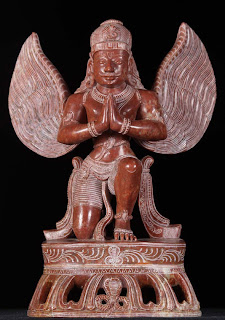 In
all Shiva temples, his vehicle, Nandi the bull, faces the figure of Shiva
symbolizing the soul of man, the Jiva, yearning for Paramatma, the Great Soul
(God).
In
all Shiva temples, his vehicle, Nandi the bull, faces the figure of Shiva
symbolizing the soul of man, the Jiva, yearning for Paramatma, the Great Soul
(God).
Cosmic
Energy in its dynamic form is symbolised for us ordinary mortals in the form of
Shakti, the World Mother, who is the power and energy by which the Great God
creates, preserves and destroys the world. She is shown in many forms. As Uma
or Parvati, she is the gentle consort of Shiva. As Kamakshi or Rajarajeshwari,
she is the Great Mother. In one hand she holds a noose, signifying worldly
attachments from which we should free ourselves. The hook in her other hand is
indicative of her prodding us on to the path of righteousness. The sugarcane
plant she carries is a symbol of the sweetness of the Mind. The arrows she
holds in one hand are our five sense-perceptions which we have to conquer. In
the form of Durga she rides the tiger, the ego and arrogance that Man has to
subdue. With the weapons in her hand she fights the eight evils (hate, greed,
passion, vanity, contempt of others, envy, jealousy and the illusions with
which man binds himself). In her angry form she is known as Kali, the
personification of Time. In this frightening form she destroys Mahishasura (the
demon buffalo) who is the symbol of ignorance which is man's greatest enemy.
Her arms and weapons are constantly flaying and fighting evil in all forms. The
skulls she wears tell you that Man is mortal. Her dark form is symbolic of the
future which is beyond our knowledge, and as Kali she tells you that Time
(Kala) is immutable and all-powerful in the Universe.
Ganesha,
also known as Ganapati or Vinayaka, is the son of Shiva and Parvati and is the
first deity to be worshipped during any ritual, as he is considered the remover
of obstacles. His huge body represents the Cosmos or Universe and his trunk the
Pranava or OM, the symbol of the Brahman. His elephant's head denotes superior
intelligence and the snake around his waist represents cosmic energy. The noose
is to remind us that wordly attachments are a noose and the hook in his hand is
to prod Man on to the path of righteousness. The rosary beads are for the
pursuit of prayer and the broken tusk is symbolic of knowledge as it is with
this tusk that he is believed to have acted as the scribe who wrote down the
Mahabharata as dictated by Sage Vyasa. The modaka or sweet in his hand is to
remind us of the sweetness of one's inner self.
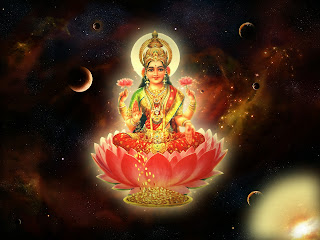
The
physical form of Ganesha is corpulent and awkward to teach us that beauty of
the outward form has no connection with inner beauty or spiritual perfection.
Ganesha, on his vehicle, the mouse, symbolises the equal importance of the
biggest and the smallest of creatures to the Great God.
The
other son of Shiva, Kartikeya, is also known as Kumara, Skanda, Subramanya,
Shanmukha or Muruga (the last name used in Tamil Nadu). As Kartikeya he is
designated the deity of war, guarding right and destroying evil. As Shanmukha,
the six-headed, he teaches that we have five senses and the mind, and only when
all six are in harmony is there spiritual growth. As Subramanya, he has two
consorts, Valli and Devasena, who embody Jnana Shakti, the power of knowledge
and Kriya Shakti, the power of action. He rides the peacock, reminding us not
to let pride and egotism get the better of us. In his hand he holds the vel or
sharp spear, symbolizing the developed sharp intellect, and with it he guards
the spiritual progress of the world.
Most
visitors to our country wonder why gods and goddesses of the Hindu Pantheon are
shown with several arms, and sometimes with several faces. The main reason is
to show them to be supernatural, just as in some religions angels are shown to
have wings. We are aware that the Supreme Brahman is formless. It is Man, in
the primitive stages of society, who has given the Great Spirit understandable
human forms of His power and His attributes, to teach the ordinary people of
His greatness, His omniscience and His omnipotence.
 Also,
one must realise that Hinduism adopted and assimilated the religious beliefs of
all the primitive tribes and peoples with whom the early Hindus came into
contact. Its tolerance of all religions is unique as it did not destroy the
beliefs of the peoples the ancient Hindus conquered but absorbed them. Every
religion which Hinduism absorbed had its own gods and beliefs (some even had
totems), and every race its own rituals and rites. Hinduism assimilated them
all, never destroying the beliefs in the gods or the totems of any of the
tribes and peoples whom the early Hindus conquered. It is one of the greatest
miracles of the spiritual world that Hinduism gathered so many, many different
religions in its fold, and brought thousands of differing religious beliefs
under the umbrella of Vedic Hinduism, with the Upanishadic aphorism, Ekam Sat
viprah bahudha vadanti' (the Great God is One, and the learned only call Him by
different names).
Also,
one must realise that Hinduism adopted and assimilated the religious beliefs of
all the primitive tribes and peoples with whom the early Hindus came into
contact. Its tolerance of all religions is unique as it did not destroy the
beliefs of the peoples the ancient Hindus conquered but absorbed them. Every
religion which Hinduism absorbed had its own gods and beliefs (some even had
totems), and every race its own rituals and rites. Hinduism assimilated them
all, never destroying the beliefs in the gods or the totems of any of the
tribes and peoples whom the early Hindus conquered. It is one of the greatest
miracles of the spiritual world that Hinduism gathered so many, many different
religions in its fold, and brought thousands of differing religious beliefs
under the umbrella of Vedic Hinduism, with the Upanishadic aphorism, Ekam Sat
viprah bahudha vadanti' (the Great God is One, and the learned only call Him by
different names).
By
the time Adi Shankara, the great Indian philosopher, arrived on the scene,
there were thousands of gods and goddesses of the various races and tribes and
innumerable and confusing rituals being performed by Hindus.
Born
in Kalady in Kerala in the 8th century, Shankara was the greatest exponent of
the Advaita philosophy (according to which God is within Man, and the Atma, the
individual soul and the Brahman, the Universal Soul are one and not two). He
refuted the Buddhist teaching that the world is totally unreal and said that
the objective world does exist in relation to the ordinary mind but is not the
Ultimate Reality. In relation to the latter, however, it is an illusion.
Travelling
by foot several times to all corners of this vast land, in his short span of
life of 32 years he established the earliest Hindu monastic order with Matams
or Ashrams in the south, west, north and east of this country. (Even today we
have Matams of this order at Sringeri and Kanchi in the south, Dwarka in the
west, Badri in the Himalayas, and Puri in the east.) Each Matam was placed
under an Acharya or teacher, called a Shankaracharya during his tenure, who
propagated Advaita or the philosophy of Monism.
As a
religious reformer in a period of spiritual crisis, as existed then (and exists
now), he taught that vijnana (intuition), vichara (enquiry), and anubhava
(experience), each have their place in spiritual experience but it is essential
for knowledge to be acquired by personal investigation and one's own experience
alone, as even the Vedas, he said, only reveal, they do not command. He
postulated that all paths to God are ancillary to Jnana Marga or the path of
knowledge.
He
was one of the great mystical seers who, with their intuitory knowledge,
anticipated many of today's scientific theories on primal energy (Shakti), the
atom (Anu), vibrations of the Universe (Shabda Brahmam), and the physical and
psychic world around us.
He
also wrote commentaries on Vedanta, the Gita and the Upanishads, and gave new
dimensions to devotional literature by including in it mysticism clothed in
exquisite poetry.
Never
forgetting the needs of the untutored devout of heart, he established new
systems of worship for their guidance. He codified popular Hinduism and grouped
all the gods and goddesses under six main streams of worship.
They
are Shaiva (worship of Shiva), Vaishnava (worship of Vishnu), Shakta (worship
of Shakti, the Mother Goddess), Saura (worship of Surya, the Sun God),
Ganapatya (worship of Ganesha or Ganapati), and Kaumara (worship of Kumara,
also known as Muruga or Subramanya). He taught that these six Bhakti-darshanas
or paths of prayer are not in conflict but are for the choice of the worshipper
striving to reach God.
Adi
Shankara is therefore called the `Shanmata-sthhapana Acharya', the teacher who
established the six-fold form of worship and taught that worship of any one of
the deities was as good as worship of the other, reaching towards a common
goal. He did not destroy any existing beliefs but brought order into the Hindu
fold in a form which did not exist earlier. Many Hindu communities which had
given up the path of Hindu beliefs came back to it, attracted by Shankara's
intellectual approach to popular religion.
From
this it must not be presumed that the aim of the Hindu is only to worship one
of these six deities. Such worship is only the means to an end. The ultimate
goal is for the individual soul in each one of us, known as the Atma, to attain
the Brahman or the Universal Soul.
Writer Name:- Shakunthala Jagannathan
 A
high degree of symbolism has been evolved to explain the attributes and
qualities of God-head to the masses.
A
high degree of symbolism has been evolved to explain the attributes and
qualities of God-head to the masses.  The
feminine aspect of the Preserver is Lakshmi, the consort of Vishnu. The grace
of God is personified in her as one who brings prosperity. One hand she holds
in the abhaya mudra (with the hand held open with the palm facing the devotee
and the fingers facing upwards) which says "Do not fear" and the
other in the varada mudra (with the hand with the palm facing the devotee but
with the fingers facing downwards) symbolic of the prosperity and grace she
gives to the human race. She sits on the lotus and holds lotus flowers in her
hand emphasizing the importance of pure living without which her grace and
giving are meaningless and prosperity but an empty shell.
The
feminine aspect of the Preserver is Lakshmi, the consort of Vishnu. The grace
of God is personified in her as one who brings prosperity. One hand she holds
in the abhaya mudra (with the hand held open with the palm facing the devotee
and the fingers facing upwards) which says "Do not fear" and the
other in the varada mudra (with the hand with the palm facing the devotee but
with the fingers facing downwards) symbolic of the prosperity and grace she
gives to the human race. She sits on the lotus and holds lotus flowers in her
hand emphasizing the importance of pure living without which her grace and
giving are meaningless and prosperity but an empty shell.  In
all Shiva temples, his vehicle, Nandi the bull, faces the figure of Shiva
symbolizing the soul of man, the Jiva, yearning for Paramatma, the Great Soul
(God).
In
all Shiva temples, his vehicle, Nandi the bull, faces the figure of Shiva
symbolizing the soul of man, the Jiva, yearning for Paramatma, the Great Soul
(God). Also,
one must realise that Hinduism adopted and assimilated the religious beliefs of
all the primitive tribes and peoples with whom the early Hindus came into
contact. Its tolerance of all religions is unique as it did not destroy the
beliefs of the peoples the ancient Hindus conquered but absorbed them. Every
religion which Hinduism absorbed had its own gods and beliefs (some even had
totems), and every race its own rituals and rites. Hinduism assimilated them
all, never destroying the beliefs in the gods or the totems of any of the
tribes and peoples whom the early Hindus conquered. It is one of the greatest
miracles of the spiritual world that Hinduism gathered so many, many different
religions in its fold, and brought thousands of differing religious beliefs
under the umbrella of Vedic Hinduism, with the Upanishadic aphorism, Ekam Sat
viprah bahudha vadanti' (the Great God is One, and the learned only call Him by
different names).
Also,
one must realise that Hinduism adopted and assimilated the religious beliefs of
all the primitive tribes and peoples with whom the early Hindus came into
contact. Its tolerance of all religions is unique as it did not destroy the
beliefs of the peoples the ancient Hindus conquered but absorbed them. Every
religion which Hinduism absorbed had its own gods and beliefs (some even had
totems), and every race its own rituals and rites. Hinduism assimilated them
all, never destroying the beliefs in the gods or the totems of any of the
tribes and peoples whom the early Hindus conquered. It is one of the greatest
miracles of the spiritual world that Hinduism gathered so many, many different
religions in its fold, and brought thousands of differing religious beliefs
under the umbrella of Vedic Hinduism, with the Upanishadic aphorism, Ekam Sat
viprah bahudha vadanti' (the Great God is One, and the learned only call Him by
different names). 




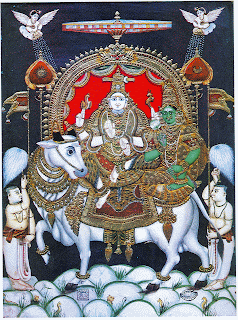
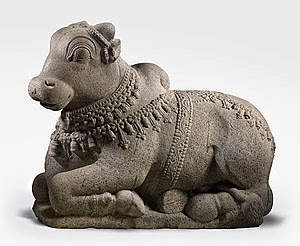
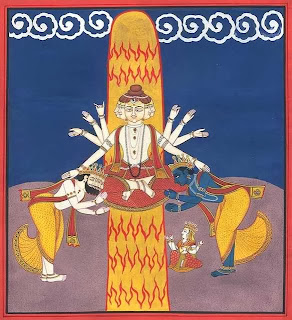










0 Response to "The Saguna Brahman, The Great God and The Trinity"
Post a Comment